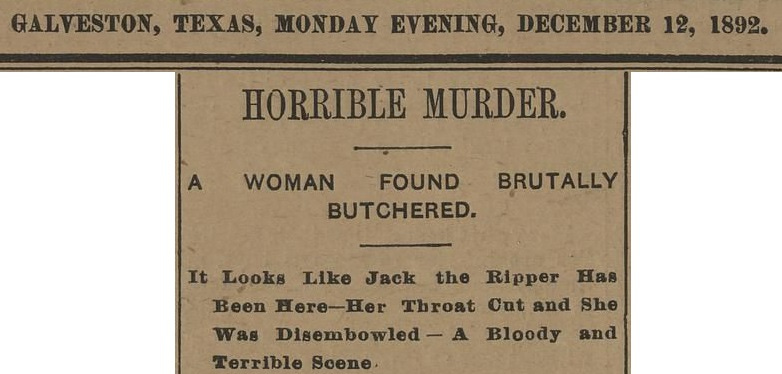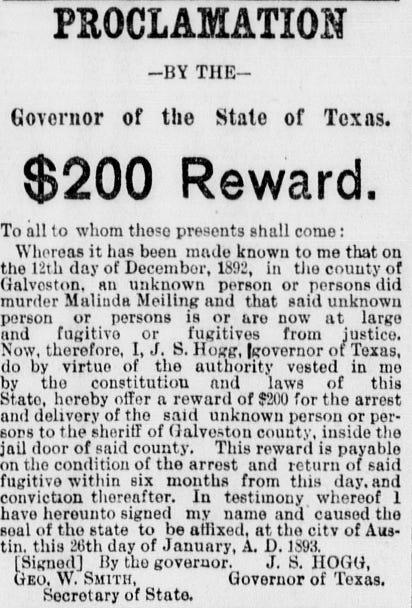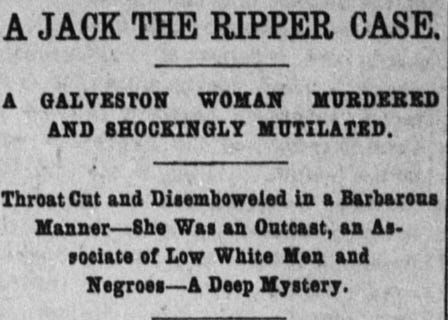Dark Whispers: The Unsolved Murder of Malinda Meiling
A tale of tragedy, mystery, and the lingering echoes of a life stolen.
On this Hallow’s Eve, I bring you a true story of murder, mystery, and the lingering echoes of a life stolen too soon. This tale will unsettle your thoughts and remind you that some spirits never truly rest. 🚨Trigger Warning: Gruesome details of murder below.
(I will have an election update later this afternoon.)
In the final weeks of 1892, as winter winds rolled across the coast of Galveston, a darkness settled over the city—one that no one could see coming. The nights were cold, the streets damp with the salty air from the nearby gulf, and a horrific discovery was about to rattle the small community to its core in one lonely corner of the island.
On the morning of December 12, a quiet, crumbling house on Avenue R ½ became the center of a chilling event. There, in the attic of the old home, Malinda Meiling, a 37-year-old woman, was found murdered in a most horrifying way—so brutal, so precise, that those who laid eyes upon the scene would never forget it.
The victim.
Malinda Meiling was known to keep to herself, living a simple life with her elderly mother in a small house. The house stood alone in 1892, and that part of the island was mostly uninhabited. Yet this morning, all were drawn to that place when the door was thrown open, and a cry rang out. Malinda was dead, her body crumpled in the attic, hidden from the single window above.
The house was dark and silent when the authorities arrived. What they found inside chilled even the most seasoned police officers. Malinda’s body had been disemboweled. Her carotid artery had been cut, and her abdomen was slashed from her chest to her pelvis—an open wound that exposed the cruel reality of the act. But it was the sight within the wound on her belly that turned the investigation into something much darker—a foot of a fetus, barely formed, sticking out of the open gash. Malinda had been pregnant, carrying a life that had been ripped from her as savagely as her own had been taken.
The crime scene.
There were no sounds of struggle, no indications of a desperate fight. The attic where Malinda was found was untouched. The small room was cramped, filled only with the essentials—a bed shared between mother and daughter and a few scattered belongings.
Her body was found crouched near the chimney, her limbs twisted in a grotesque final pose as if she had been caught mid-movement. The blood pooled beneath her was the only evidence of violence—the only proof that something terrible had happened there. There were no bloody footprints, no knife, no hint of a struggle elsewhere in the house. Her death was quiet.
In the dim light of the attic, the scene felt wrong—not just because of its brutality but also because of its calmness.
The authorities were baffled. There was no sign of a break-in, no sign of a struggle. No one had seen anyone enter or leave the house that night, yet Malinda Meiling was dead in such a way that none could explain. The investigation would soon begin, and a question hung over everyone who dared approach that old house: What kind of evil had done this?
The Investigation.
When the body of Malinda Meiling was discovered, it was her mother, Christina Meiling, who raised the alarm. The old woman, trembling and incoherent, was the first to witness the brutal aftermath of her daughter’s murder. But as the authorities began to piece together the details, the story she told them was anything but straightforward.
Christina Meiling had been living in the same house with her daughter, sharing the small, cramped attic space. In her initial statements, she claimed that she had gone to bed beside Malinda on the night of December 11, only to awaken the following day to find her daughter dead near the chimney. But her account changed each time she was questioned. Sometimes, she claimed to have slept in a separate room, unable to explain how she hadn’t heard any noise. Other times, her words were slurred and confused. It turned out that the whiskey bottles found scattered around the house were hers, and she was sloshed.
The inconsistencies in her statements made the investigators suspicious. Christina had been drunk the night her daughter died, and the authorities noted blood on her stockings—a detail that only added to the growing doubt about her involvement. Had she been the one to murder her daughter in a drunken rage? Or was she too intoxicated to remember what had truly happened that night?
Yet, despite the questions surrounding her, Christina was never charged with the crime. As erratic and unreliable as her testimony was, there was no concrete evidence linking her to the murder. The police had no motive and no weapon, only her slurred and contradictory statements. And so, Christina Meiling remained a focal point in the investigation, her guilt or innocence forever shrouded in uncertainty. The authorities, desperate for answers, widened their search.
The suspects
As the days turned into weeks and then into months, two names began to emerge from the shadows of the investigation—names whispered among those who lived in the area and passed through the streets near Avenue R ½.
Davis.
The first was a man known only as Davis, a mysterious figure who had reportedly been seen near the house on the night of the murder. Davis was a “transient laborer,” drifting between Galveston and the neighboring towns of Louisiana and Texas. Rumors swirled about his possible involvement, and several people claimed to have spotted him not far from the scene of the crime in the days following Malinda’s death. But Davis seemed to disappear just as quickly as he had come.
Multiple sightings of him were reported across Louisiana and Texas, and the police followed these leads with a desperation that grew sharper with each passing day. They tracked him through small towns and along dusty roads, but Davis slipped away every time they seemed close—changing his route, blending into the crowds, and leaving the authorities empty-handed.
There was no proof that Davis had killed Malinda, no clear evidence linking him to the scene, but his ability to evade capture only deepened the suspicion around him. Each failed attempt to bring him in only raised more questions. Who was this man, and why was he running?
Richard Freeman.
Then, in February of 1893, a new figure entered the investigation. Richard Freeman, a man with a history of petty theft, was arrested on unrelated charges. It was during his interrogation that he, seemingly out of nowhere, confessed to the murder of Malinda Meiling. His confession, however, was anything but solid.
Freeman’s account of the crime was vague, his words disjointed, and the more the investigators questioned him, the more uncertain they became. He admitted to killing Malinda, but only after a police officer suggested that he had done it. There were gaps in his story, contradictions that couldn’t be explained away, and some wondered if he even understood the gravity of what he was admitting to.
Authorities were skeptical, primarily since Freeman had been known for his erratic behavior. His confession seemed forced, an echo of words rather than a genuine admission of guilt. Had Freeman told the officers what they wanted to hear, desperate to escape the pressure of the interrogation? Or was he genuinely responsible for the gruesome death of Malinda Meiling? The truth remained elusive, and with no solid evidence to support his claims, Freeman’s confession left the investigators with more questions than answers.
The role of the media.
As the investigation dragged on, the Galveston newspapers seized on the gruesome details of the case, fueling speculation and fear. The precise nature of the crime—Malinda’s severed carotid artery, the surgical slashes to her abdomen—led the press to suggest something more sinister, something darker lurking in the city.
It wasn’t long before the name Jack the Ripper appeared in the headlines. The papers linked the murder to the infamous London killer, calling it “Horrible Work Skillfully Done.” The comparison to Ripper-like precision captivated the public, and rumors of a shadowy figure stalking the streets of Galveston spread like wildfire. Whispers of the Ripper’s ghost haunted the city, and the fear that such a killer could have found his way to their shores kept the community on edge.
Amid it all, the Evening Tribune became a champion for justice, relentlessly covering the case and pressuring the authorities to take action. The newspaper called for a reward to be offered, arguing that the murder must not go unsolved. Their demands finally led Governor Hogg to provide a $200 reward for any information that would lead to the capture of Malinda’s killer. But even this was seen as too little, too late by many who feared that whoever had killed Malinda had long since disappeared.
Public response.
As the investigation into Malinda Meiling’s murder dragged on, the public’s patience wore thin. What began as shock and horror soon transformed into anger and frustration. The people of Galveston were outraged by the lack of progress in solving the case. It was not just the brutality of the crime that haunted them—it was the growing realization that the authorities, despite their efforts, seemed no closer to catching the killer.
Whispers spread through the town, and murmurs of incompetence from the police were heard in taverns, shops, and street corners. Many believed the investigation had been mishandled and that too much time had been wasted pursuing false leads and questioning the wrong people. Every delay only deepened the wound left by Malinda’s death, and as months passed with no arrest, the community’s sense of helplessness grew.
Newspapers fanned the flames of discontent, their headlines becoming more sensational as winter turned to spring. Reporters criticized the authorities for failing to catch the murderer, pointing out the delays in offering a reward and the disorganized nature of the investigation. Articles reflecting the public’s dissatisfaction increased, noting the failure to bring in Davis, the man most believed guilty. As the pressure mounted, the authorities found themselves not only trying to solve the murder but also defending themselves against an increasingly hostile public.
Rumors swirled—who could have done such a thing, and why hadn’t they been caught? There were accusations, wild and unsubstantiated, that led to the arrest of several local men. However, these arrests turned out to be false leads each time, with the accused being quickly released after no evidence could be found. These missteps further enraged the community. It felt to them as if the killer was taunting the city, walking freely among them while the authorities floundered.
No resolution.
Despite the investigations, rumors, and rewards, no resolution ever came. Davis—the man seen in the area—remained a phantom, always out of reach, and his capture never came. Richard Freeman’s confession, riddled with contradictions and doubt, was dismissed as unreliable, leaving the case again stagnant.
With each passing month, the likelihood of solving Malinda Meiling’s murder diminished. The police followed every lead and questioned anyone with information, but the case seemed cursed. False arrests tarnished the investigation’s credibility, and by the summer of 1893, the trail had gone cold.
Malinda’s death would remain a dark mark on the city’s history—one of the most brutal murders Galveston had ever seen, and yet, one that would never be solved. The killer’s identity, the reasons behind the horrific crime, and even the fate of Davis all became mysteries lost to time. The investigation, marked by false leads, public frustration, and accusations of incompetence, faded into the background.
No one was ever convicted for the murder of Malinda Meiling, and the streets of Avenue R ½ would never feel the same again. The house where she was killed eventually fell silent, but the echoes of her tragedy lingered, a chilling reminder that sometimes justice never comes.
The haunting cry of Avenue R ½.
The story of Malinda Meiling may have faded from the headlines, but for those who walked the streets near Avenue R ½, her presence never truly left. The house where she was brutally murdered no longer stands, but those who pass through the area say that something lingers—a coldness that clings to the air, even in the warmth of a Galveston summer. And in the still of the night, when the city quiets and the wind sweeps through the empty streets, something more unsettling begins to stir.
People speak of a voice—a woman’s voice, faint but filled with an unmistakable grief. It comes without warning, carried on the wind like a whisper from another time. They say that when the streets are deserted late at night, you can hear her cry out in the darkness: “Where is my baby?”
The first reports of the voice came from those who lived nearby. At first, they dismissed it—just the wind, they thought, or perhaps a distant echo from the seafront. But the voice persisted, heard by too many to be mere coincidence. It was always the same—a cry, desperate and heartbroken, as though the woman who spoke those words was searching for something she could never find.
There is no figure to accompany the voice—no shadowy apparition drifting through the streets, no ghostly silhouette to match the tragic cry. It is the absence that makes it all the more terrifying. You never see her, only hear her sorrow, echoing from somewhere beyond, as if she’s trapped in a moment that can never be undone.
And it’s always the same question: “Where is my baby?”
November 1: Last day to early vote.
November 5: Election day!
LoneStarLeft’s Newsletter is a reader-supported publication. To receive new posts and support my work, consider becoming a free or paid subscriber.
Follow me on Facebook, Twitter, TikTok, Threads, YouTube, and Instagram.









